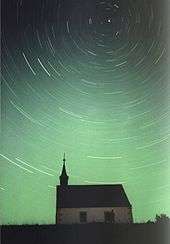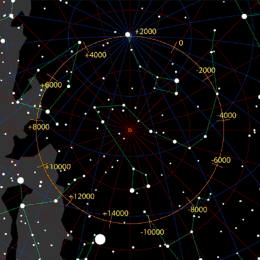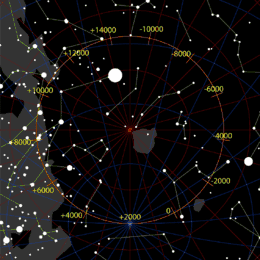Pole star
A pole star or polar star is a star, preferably bright, nearly aligned with the axis of a rotating astronomical body.

Currently, Earth's pole stars are Polaris (Alpha Ursae Minoris), a magnitude-2 star aligned approximately with its northern axis, and a pre-eminent star in celestial navigation, and Polaris Australis (Sigma Octantis), a much dimmer star. From around 1700 BC until just after 300 AD, Kochab and Pherkad were twin northern pole stars, though neither was as close to the pole as Polaris is now.
History


In classical antiquity, Beta Ursae Minoris (Kochab) was closer to the celestial north pole than Alpha Ursae Minoris. While there was no naked-eye star close to the pole, the midpoint between Alpha and Beta Ursae Minoris was reasonably close to the pole, and it appears that the entire constellation of Ursa Minor, in antiquity known as Cynosura (Greek Κυνόσουρα "dog's tail")[1] was used as indicating the northern direction for the purposes of navigation by the Phoenicians.[2] The ancient name of Ursa Minor, anglicized as cynosure, has since itself become a term for "guiding principle" after the constellation's use in navigation.
Alpha Ursae Minoris (Polaris) was described as ἀειφανής (tranliterated as aiphanes) meaning "always visible"[3] by Stobaeus in the 5th century, when it was still removed from the celestial pole by about 8°. It was known as scip-steorra ("ship-star") in 10th-century Anglo-Saxon England, reflecting its use in navigation. In the Hindu Puranas, it is personified under the name Dhruva ("immovable, fixed").
In the medieval period, Polaris was also known as stella maris "star of the sea" (from its use for navigation at sea), as in e.g. Bartholomeus Anglicus (d. 1272), in the translation of John Trevisa (1397):
- "by the place of this sterre place and stedes and boundes of the other sterres and of cercles of heven ben knowen: therefore astronomers beholde mooste this sterre. Then this ster is dyscryved of the moste shorte cercle; for he is ferre from the place that we ben in; he hydeth the hugenesse of his quantite for unmevablenes of his place, and he doth cerfifie men moste certenly, that beholde and take hede therof; and therfore he is called stella maris, the sterre of the see, for he ledeth in the see men that saylle and have shyppemannes crafte."[4]
Polaris was associated with Marian veneration from an early time, Our Lady, Star of the Sea being a title of the Blessed Virgin. This tradition goes back to a misreading of Saint Jerome's translation of Eusebius' Onomasticon, De nominibus hebraicis (written ca. 390). Jerome gave stilla maris "drop of the sea" as a (false) Hebrew etymology of the name Maria. This stilla maris was later misread as stella maris; the misreading is also found in the manuscript tradition of Isidore's Etymologiae (7th century);[5] it probably arises in the Carolingian era; a late 9th-century manuscript of Jerome's text still has stilla, not stella,[6] but Paschasius Radbertus, also writing in the 9th century, makes an explicit reference to the "Star of the Sea" metaphor, saying that Mary is the "Star of the Sea" to be followed on the way to Christ, "lest we capsize amid the storm-tossed waves of the sea."[7]
The name stella polaris was coined in the Renaissance, even though at that time it was well recognized that it was several degrees away from the celestial pole; Gemma Frisius in the year 1547 determined this distance as 3°8'.[8] An explicit identification of Mary as stella maris with the North Star (Polaris) becomes evident in the title Cynosura seu Mariana Stella Polaris (i.e. "Cynosure, or the Marian Polar Star"), a collection of Marian poetry published by Nicolaus Lucensis (Niccolo Barsotti de Lucca) in 1655.
Precession of the equinoxes

As of October 2012, Polaris had the declination +89°19′8″ (at epoch J2000 it was +89°15′51.2″). Therefore, it always appears due north in the sky to a precision better than one degree, and the angle it makes with respect to the true horizon (after correcting for refraction and other factors) is equal to the latitude of the observer to better than one degree. The celestial pole will be nearest Polaris in 2100 and will thereafter become more distant.[9][10]
Due to the precession of the equinoxes (as well as the stars' proper motions), the role of North Star has passed (and will pass) from one star to another in the remote past (and in the remote future). In 3000 BC, the faint star Thuban in the constellation Draco was the North Star, aligning within 0.1° distance from the celestial pole, the closest of any of the visible pole stars.[11][12] However, at magnitude 3.67 (fourth magnitude) it is only one-fifth as bright as Polaris, and today it is invisible in light-polluted urban skies.
During the 1st millennium BC, Beta Ursae Minoris ("Kochab") was the bright star closest to the celestial pole, but it was never close enough to be taken as marking the pole, and the Greek navigator Pytheas in ca. 320 BC described the celestial pole as devoid of stars.[9][13] In the Roman era, the celestial pole was about equally distant between Polaris and Kochab.
The precession of the equinoxes takes about 25,770 years to complete a cycle. Polaris' mean position (taking account of precession and proper motion) will reach a maximum declination of +89°32'23", which translates to 1657" (or 0.4603°) from the celestial north pole, in February 2102. Its maximum apparent declination (taking account of nutation and aberration) will be +89°32'50.62", which is 1629" (or 0.4526°) from the celestial north pole, on 24 March 2100.[10]
Precession will next point the north celestial pole at stars in the northern constellation Cepheus. The pole will drift to space equidistant between Polaris and Gamma Cephei ("Errai") by 3000 AD, with Errai reaching its closest alignment with the northern celestial pole around 4200 AD.[14][15] Iota Cephei and Beta Cephei will stand on either side of the northern celestial pole some time around 5200 AD, before moving to closer alignment with the brighter star Alpha Cephei ("Alderamin") around 7500 AD.[14][16]
Precession will then point the north celestial pole at stars in the northern constellation Cygnus. Like Beta Ursae Minoris during the 1st millennium BC, the bright star closest to the celestial pole in the 10th millennium AD, first-magnitude Deneb, will be a distant 7° from the pole, never close enough to be taken as marking the pole,[11] while third-magnitude Delta Cygni will be a more helpful pole star, at a distance of 3° from celestial north, around 11,500 AD.[14] Precession will then point the north celestial pole nearer the constellation Lyra, where the second brightest star in the northern celestial hemisphere, Vega, will be a pole star around 13,700 AD, though at a distance of 5° from celestial north.[14]
Precession will eventually point the north celestial pole nearer the stars in the constellation Hercules, pointing towards Tau Herculis around 18,400 AD.[17] The celestial pole will then return to the stars in constellation Draco (Thuban, mentioned above) before returning to the current constellation, Ursa Minor. When Polaris becomes the North Star again around 27,800 AD, due to its proper motion it then will be farther away from the pole than it is now, while in 23,600 BC it was closer to the pole.
Over the course of Earth's 26,000-year axial precession cycle, a series of bright naked eye stars (an apparent magnitude up to +6; a full moon is −12.9) in the northern hemisphere will hold the transitory title of North Star.[14] While other stars might line up with the north celestial pole during the 26,000 year cycle, they do not necessarily meet the naked eye limit needed to serve as a useful indicator of north to an Earth-based observer, resulting in periods of time during the cycle when there is no clearly defined North Star. There will also be periods during the cycle when bright stars give only an approximate guide to "north", as they may be greater than 5° of angular diameter removed from direct alignment with the north celestial pole.[15]
The 26,000 year cycle of North Stars, starting with the current star, with stars that will be "near-north" indicators when no North Star exists during the cycle, including each star's average brightness and closest alignment to the north celestial pole during the cycle:[9][10][11][12][14][15][16][17]
| Bayer | Traditional | V | Constellation | Alignment | notes |
|---|---|---|---|---|---|
| Alpha Ursae Minoris | Polaris | 1.98 | Ursa Minor | within 0.5° | current North Star |
| Gamma Cephei | Errai | 3.21 | Cepheus | within 3° | binary star system |
| Iota Cephei | 3.51 | Cepheus | within 5° | shares timing with Beta Cephei | |
| Beta Cephei | Alfirk | 3.51 | Cepheus | within 5° | shares timing with Iota Cephei |
| Alpha Cephei | Alderamin | 2.51 | Cepheus | within 3° | |
| Alpha Cygni | Deneb | 1.25 | Cygnus | within 7° | a near-north star |
| Delta Cygni | Fawaris | 2.87 | Cygnus | within 3° | |
| Alpha Lyrae | Vega | 0.026 | Lyra | within 5° | brightest North Star |
| Iota Herculis | 3.75 | Hercules | within 4° | ||
| Tau Herculis | 3.89 | Hercules | within 1° | ||
| Iota Draconis | Edasich | 3.29 | Draco | within 5° | |
| Alpha Draconis | Thuban | 3.65 | Draco | within 0.2° | closest to celestial pole when North Star |
| Kappa Draconis | 3.82 | Draco | within 6° | a near-north star, shares timing with Kochab | |
| Beta Ursae Minoris | Kochab | 2.08 | Ursa Minor | within 7° | a near-north star, shares timing with κ Draconis |
Southern pole star (South Star)
Currently, there is no South Star as useful as Polaris. Sigma Octantis is the closest naked-eye star to the south Celestial pole, but at apparent magnitude 5.45 it is barely visible on a clear night, making it unusable for navigational purposes.[18] It is a yellow giant 275 light years from Earth. Its angular separation from the pole is about 1° (as of 2000). The Southern Cross constellation functions as an approximate southern pole constellation, by pointing to where a southern pole star would be.
At the equator, it is possible to see both Polaris and the Southern Cross.[19][20] The Celestial south pole is moving toward the Southern Cross, which has pointed to the south pole for the last 2000 years or so. As a consequence, the constellation is no longer visible from subtropical northern latitudes, as it was in the time of the ancient Greeks.
Around 200 BC, the star Beta Hydri was the nearest bright star to the Celestial south pole. Around 2800 BC, Achernar was only 8 degrees from the south pole.

In the next 7500 years, the south Celestial pole will pass close to the stars Gamma Chamaeleontis (4200 AD), I Carinae, Omega Carinae (5800 AD), Upsilon Carinae, Iota Carinae (Aspidiske, 8100 AD) and Delta Velorum (Alsephina, 9200 AD).[21] From the eightieth to the ninetieth centuries, the south Celestial pole will travel through the False Cross. Around 14,000 AD Canopus will have a declination of –82°, meaning it will rise and set daily for latitudes between 8°S and 8°N, and will not rise to viewers north of this latter 8th parallel north.[22]
Notable angular apexes of Sirius's and our solar system's related and therefore somewhat complex proper motions are predicted: 88.4° S declination in the year 66,270; and 87.7° S declination in the year 93,830 AD.[23]
Other planets
Pole stars of other planets are defined analogously: they are stars (brighter than 6th magnitude, i.e., visible to the naked eye under ideal conditions) that most closely coincide with the projection of the planet's axis of rotation onto the Celestial sphere. Different planets have different pole stars because their axes are oriented differently. (See Poles of astronomical bodies.)
- Alpha Pictoris is the south pole star of Mercury while Omicron Draconis is the north star.[24]
- 42 Draconis is the closest star to the north pole of Venus. Eta¹ Doradus is the closest to the south pole. (Note: The IAU uses the right-hand rule to define a positive pole for the purpose of determining orientation. Using this convention, Venus is tilted 177° ("upside down").)[25]
- The lunar south pole star is Delta Doradus, and the north pole star[26] Omicron Draconis.
- Kappa Velorum is only a couple of degrees from the south Celestial pole of Mars. The top two stars in the Northern Cross, Sadr and Deneb, point to the north Celestial pole of Mars.[27]
- The north pole of Jupiter is a little over two degrees away from Zeta Draconis, while its south pole is about two degrees north of Delta Doradus.
- Delta Octantis is the south pole star of Saturn. Its north pole is in the far northern region of Cepheus, about six degrees from Polaris.
- Eta Ophiuchi is the north pole star of Uranus, and 15 Orionis is its south pole star.
- The north pole of Neptune points to a spot midway between Gamma and Delta Cygni. Its south pole star is Gamma Velorum.
See also
References
- κυνόσουρα. Liddell, Henry George; Scott, Robert; A Greek–English Lexicon at the Perseus Project.
- implied by Johannes Kepler (cynosurae septem stellas consideravit quibus cursum navigationis dirigebant Phoenices): "Notae ad Scaligeri Diatribam de Aequinoctiis" in Kepleri Opera Omnia ed. Ch. Frisch, vol. 8.1 (1870) p. 290
- ἀειφανής in Liddell and Scott.
- cited after J. O. Halliwell, (ed.), The Works of William Shakespeare vol. 5 (1856), p. 40.]
- Conversations-Lexicon Für Bildende Kunst vol. 7 (1857), 141f.
- A. Maas,"The Name of Mary", The Catholic Encyclopedia (1912)
- stella maris, sive illuminatrix Maria, inter fluctivagas undas pelagi, fide ac moribus sequenda est, ne mergamur undis diluvii PL vol. 120, p. 94.
- Gemmae Frisii de astrolabo catholico liber: quo latissime patentis instrumenti multiplex usus explicatur, & quicquid uspiam rerum mathematicarum tradi possit continetur, Steelsius (1556), p. 20
- Ridpath, Ian (1988). "Chapter Three: The celestial eighty-eight – Ursa Minor". Star Tales. Cambridge: The Lutterworth Press. ISBN 978-0-7188-2695-6.
...in the early 16th century ... Polaris was still around three and a half degrees from the celestial pole ...will reach its closest to the north celestial pole around AD 2100, when the separation will be less than half a degree
- Jean Meeus, Mathematical Astronomy Morsels Ch. 50; Willmann-Bell 1997
- Ridpath, Ian, ed. (2004). Norton's Star Atlas. New York: Pearson Education. p. 5. ISBN 0-13-145164-2.
Around 4800 years ago Thuban (α Draconis) lay a mere 0°.1 from the pole. Deneb (α Cygni) will be the brightest star near the pole in about 8000 years' time, at a distance of 7°
- Moore, Patrick (2005). The Observer's Year: 366 Nights in the Universe. p. 283.
- Kaler, James B., "KOCHAB (Beta Ursae Minoris)", Stars, University of Illinois, retrieved 2018-04-28
- Our Monthly, 4, Presbyterian Magazine Company, 1871, p. 53.
- McClure, Bruce; Deborah, Byrd (2017-09-29). "Gamma Cephei: A future Pole Star". EarthSky. Retrieved 2018-04-25.
- Kaler, James B., "ALDERAMIN (Alpha Cephei)", Stars, University of Illinois, retrieved 2018-04-28
- Kaler, James B., "TAU HER (Tau Herculis)", Stars, University of Illinois, retrieved 2018-04-27
- "Sigma Octantis". Jumk.De. 6 August 2013.
- "The North Star: Polaris". Space.com. May 7, 2012. Retrieved 6 August 2013.
- Hobbs, Trace (May 21, 2013). "Night Sky Near the Equator". Wordpress. Retrieved 6 August 2013.
- "Precession". moonkmft.co.uk. Retrieved 24 September 2018.
- Kieron Taylor (1 March 1994). "Precession". Sheffield Astronomical Society. Retrieved 2018-09-24.
- Bruce McClure. "Sirius, future South Pole Star". EarthSky. Retrieved 2018-01-03.
- 2004. Starry Night Pro, Version 5.8.4. Imaginova. ISBN 978-0-07-333666-4. www.starrynight.com
- Archinal, Brent A.; A'Hearn, Michael F.; Bowell, Edward G.; Conrad, Albert R.; Consolmagno, Guy J.; et al. (2010). "Report of the IAU Working Group on Cartographic Coordinates and Rotational Elements: 2009" (PDF). Celestial Mechanics and Dynamical Astronomy. 109 (2): 101–135. Bibcode:2011CeMDA.109..101A. doi:10.1007/s10569-010-9320-4. Archived from the original (PDF) on 2016-03-04. Retrieved 2018-09-06.
- note: due to axial precession, the lunar pole describes a small circle on the celestial sphere every 18.6 years. Patrick Moore (1983), The Guinness Book of Astronomy Facts & Feats, p. 29,
In 1968 the north pole star of the Moon was Omega Draconis; by 1977 it was 36 Draconis. The south pole star is Delta Doradus.
- http://www.eknent.com/etc/mars_np.png
External links
| Look up pole star in Wiktionary, the free dictionary. |
| Look up Pole Star in Wiktionary, the free dictionary. |
- van Leeuwen, F. (2007). "HIP 11767". Hipparcos, the New Reduction. Retrieved 2011-03-01.
- Star trails around Polaris